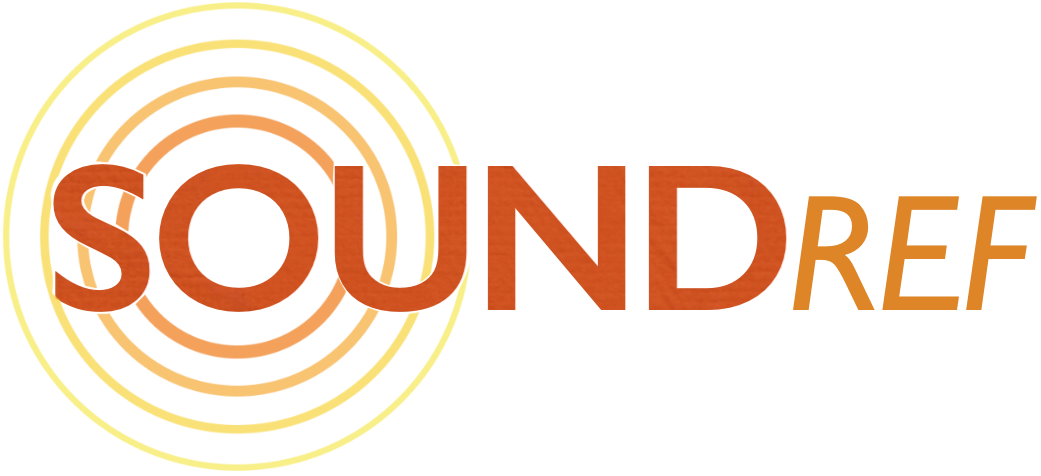The Definitive Neumann U87 AI Review
Is the U87 really the ultimate choice for your recording studio?
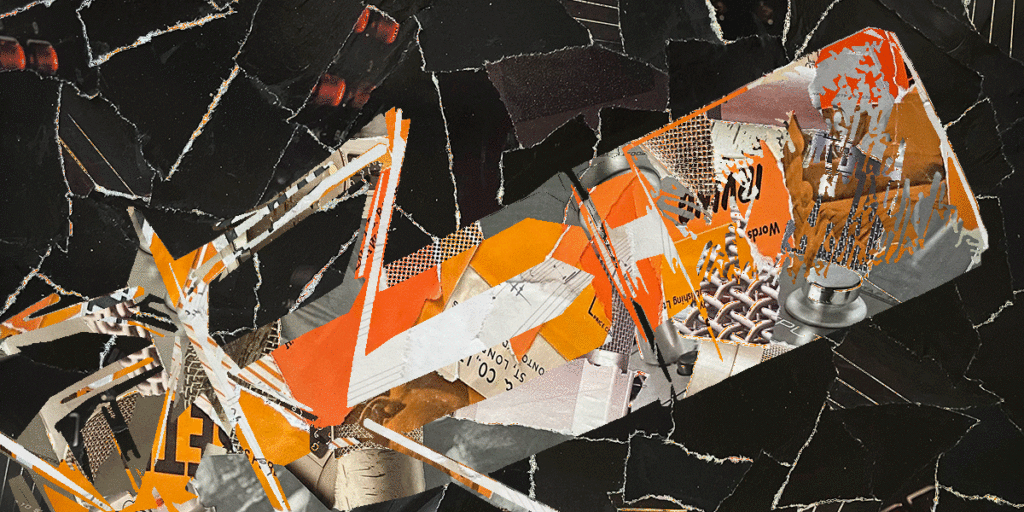
Reviewed by: Paul Narang
Latest update: December 2023
Current price: Around $3,500
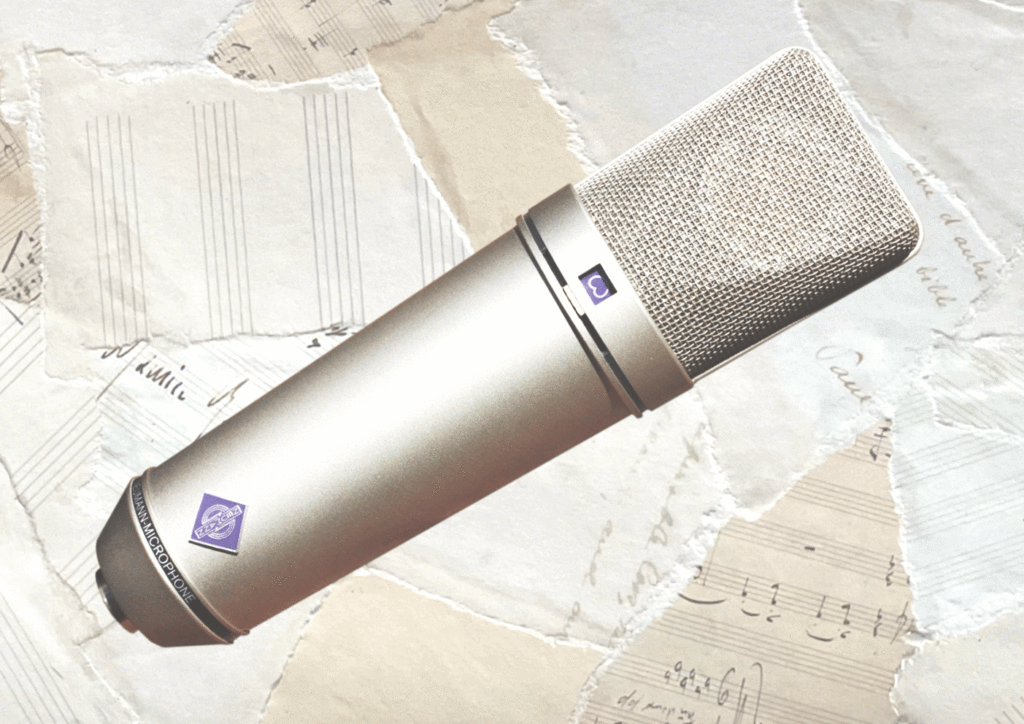

Neumann U87 AI Review
| Pros: | Cons: |
| Incredible, classic sound Extremely high build quality Switchable Polar Patterns | Very expensive Accessories are expensive Picks up ambient and background noise |
Neumann U87 AI Review
Known for it’s clear, detailed balanced tone and excellent build quality, the Neumann U87 is one of the most highly regarded microphones in the world. Earning a solid reputation over the last five decades, it features on countless classic recordings from the Beatles to the Berlin Philharmonic Orchestra.
What is it?
The Neumann company was founded in 1928, and has a long history of innovative recording technology. They made the first ever commercially available condenser mic, and were the first to release a microphone with switchable polar patterns in 1949.
This line of innovation eventually lead to the U87 on reviews, which was first released in 1967. It was an instant classic, and has been used in the studio by world-renowned artists including Stevie Wonder, Kurt Cobain, Jeff Buckley, Beyonce and many more.
The Neumann U 87 is a side-address solid state condenser microphone with switchable polar patterns. You can choose between cardioid, omni-directional and figure-of-eight polar patterns at the flick of a switch. This makes the U87 indispensable for a variety of recording needs in the studio, from recording vocals to all types of acoustic instruments.
Although the internal circuit of the mic has had many tweaks over the years, the current version (U87 AI) has the same classic sound as the original.
In the box
Just in case you had any doubt about how special the U87 is, its presented in a beautiful solid wood box. It certainly adds to the appeal, and harks back to the earlier days of high end studio mics.
There’s an alternative option called the ‘Studio Set’, which includes a custom shock mount and windshield.
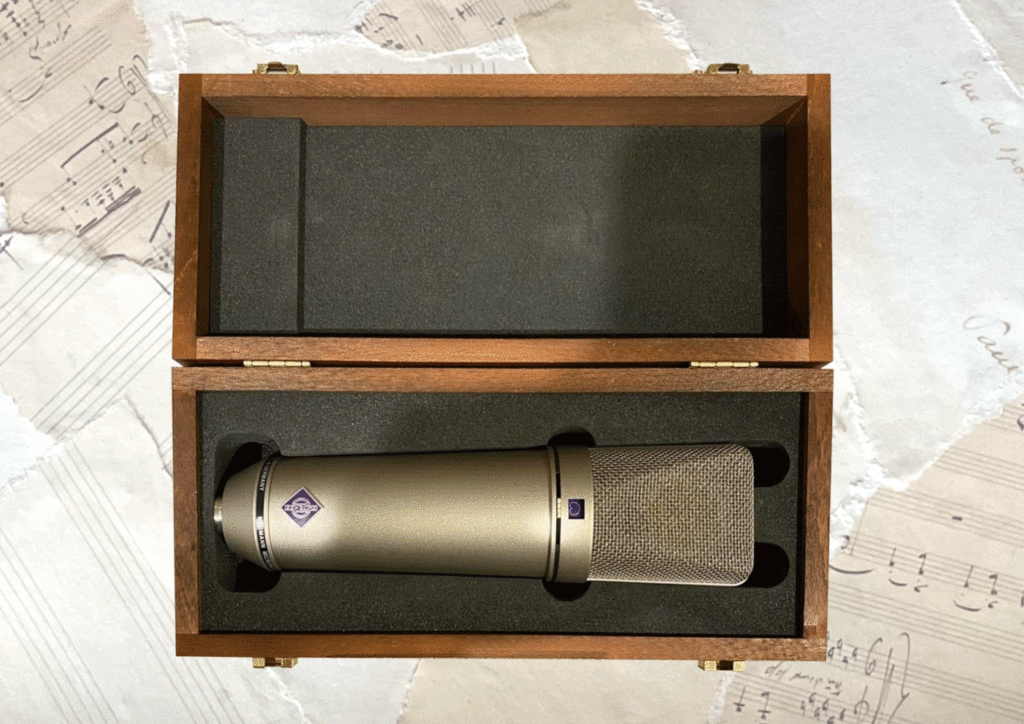
Dynamic vs condenser microphones
There’s two main types of microphones – condensers and dynamics, with the Neumann U87 AI being a classic large diaphragm condenser mic.
But what are the differences between condenser and dynamic microphones, and is a condenser mic the right choice for you?
Dynamic microphones
Dynamic mics, such as the Shure SM58 are extremely durable, and can withstand a certain amount of rough and tumble. The robust mechanism means they’re also less sensitive to distortion from high sound levels.
However, the weight of the coil limits how responsive the mic can be, and it tends to struggle to replicate high frequencies and dynamic detail.
Dynamic mics are particularly suited to live and stage use. They’re ‘passive’ meaning they don’t require any power.
Condenser microphones
On the other hand, condenser mics don’t have all the sonic limitations of dynamics, and can deliver a lot of detail and clarity. They tend to be used for studio recording due to their ability to reproduce sound so accurately.
Condensers offer a higher output level than dynamic mics, but they’re a lot more sensitive to loud noises, handling noise, and tend to be more fragile. They’re ‘active’ meaning they need a supply of ‘phantom power’.
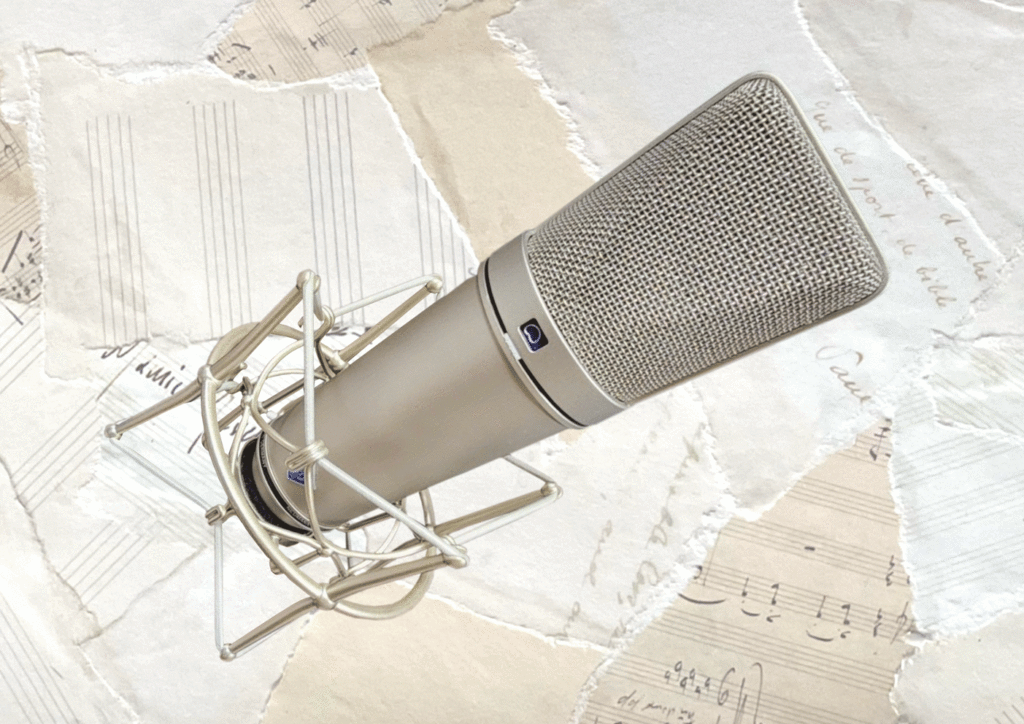
The Neumann U87 AI Polar patterns
The Neumann U87 has 3 selectable polar patterns:
- Omnidirectional
- Cardioid
- Bi-directional (aka figure of eight)
Omnidirectional

The omnidirectional pattern picks up sound evenly from all around the microphone, including the back front and sides. Although sound sources normally come from one direction, the omnidirectional pattern will also include the room ambience.
Using a U87 in omni will give your recordings an open, natural sound, and is often the choice for both vocalists and instrumentalists. Of course, the room you record in will have to sound great for this to work. You could opt for a large deadened room, or something bigger with a good natural sound like a hall or church.
Cardioid

The cardioid position provides a tighter sound with more directionality and isolation. Select the cardioid position on the U87 for on-stage applications such as miking up guitar cabs, acoustic pianos or drum overheads.
It can also be used in the studio with a reflection filter in the studio, for an up-front and contemporary pop vocal.
Bi-directional (Figure eight)
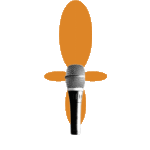
The U87 in figure of 8 position is ideal for more specialised situations. It can be used with another mic for a ‘mid-side recording’ set up, or to record backing singers, one on either side of the mic.
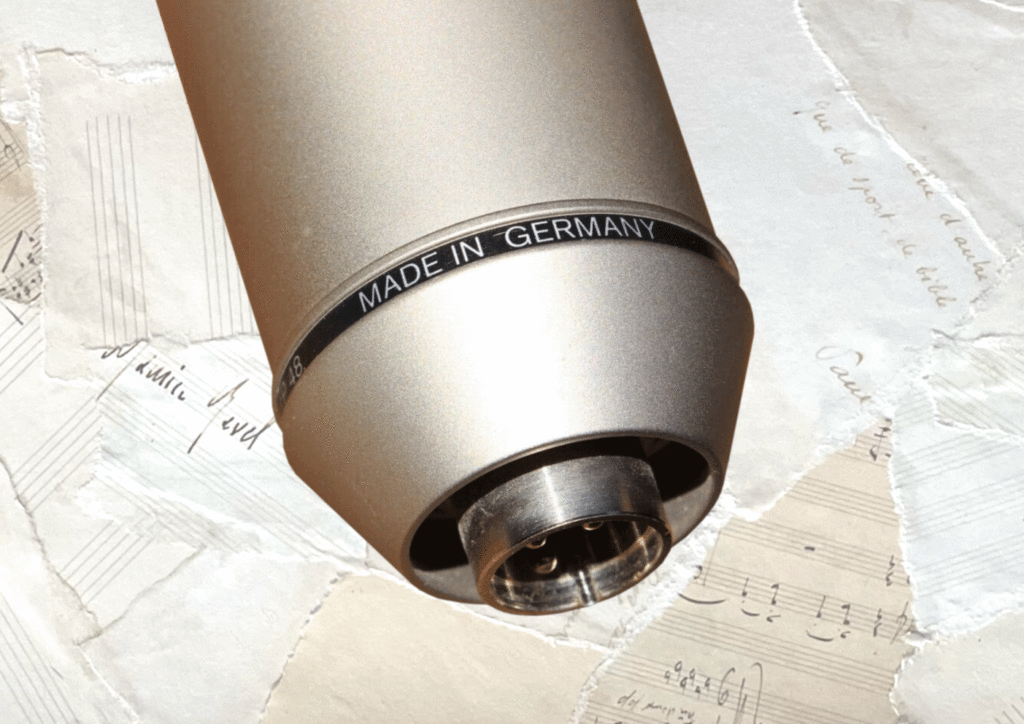
Phantom power for the Neumann U87 AI?
As a condenser microphone, the Neumann U87 AI requires phantom power. Phantom power is a small, low voltage current sent to the microphone from a microphone preamp, mixing desk, or audio interface.
Most industry standard desks or interfaces are capable of providing phantom power, which is sent through the XLR cable to the microphone.
If your audio interface or mixer doesn’t provide phantom power, there is another solution: connect your mic to an external 48 volt phantom supply. Then connect the output of the phantom supply to the mixer, or audio interface.
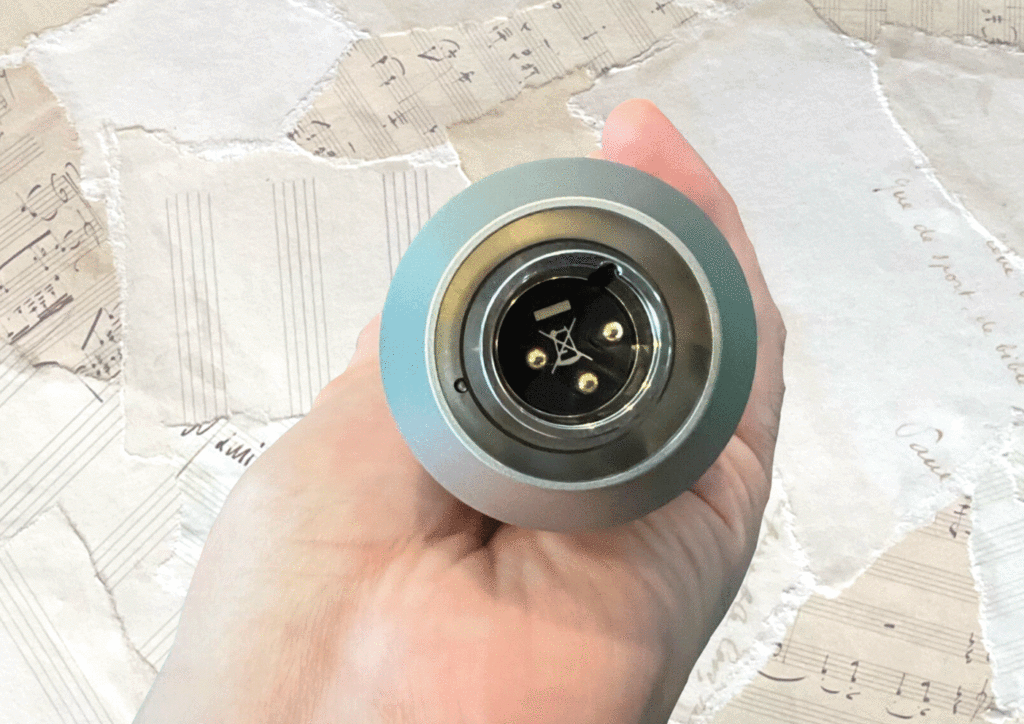
Connecting the AKG Neumann U87
The U87 uses an XLR cable to connect directly to the audio interface or mixer. XLR is the standard connector for professional studio equipment. An XLR connector is ‘balanced’, which means the cable is shielded from interference and carries a higher signal than unbalanced cables.
XLR cables are the only cables capable of carrying phantom power to the mic.
The Neumann U87 AI Design and Build
Even if you haven’t seen a Neumann U87 before, I think it’s distinctive shape might seem strangely familiar. It was a unique design when first introduced in the 1960s, but has since become the blueprint for designing other studio condensers. Its smooth metal contours and rectangular headgrille give it that classic vintage look.
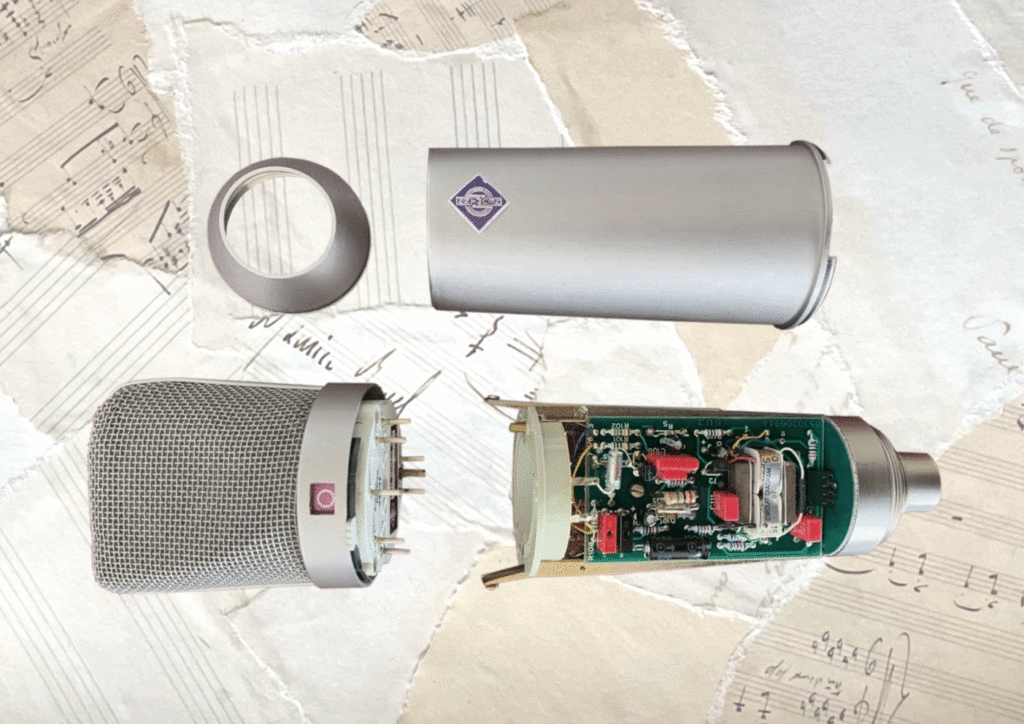
The U87’s all-metal body is nickel coloured by default, but also available in black (the U87 AI MT). Each microphone is hand built in Germany, and the build quality is nothing short of outstanding.
Inside, the U87 has the classic K67 style capsule which you’ll also find in its older sibling, the U67. But unlike the U67, which is a tube microphone, the U87 has a solid-state FET transducer, which I prefer for the clean sound and overall reliability.
There are three small switches on the mic, positioned just below the grille. On the front you can choose between figure-of-eight, cardioid or omnidirectional polar patterns. On the rear you’ll find switches for the low-cut filter and the -10dB pre attenuation pad.
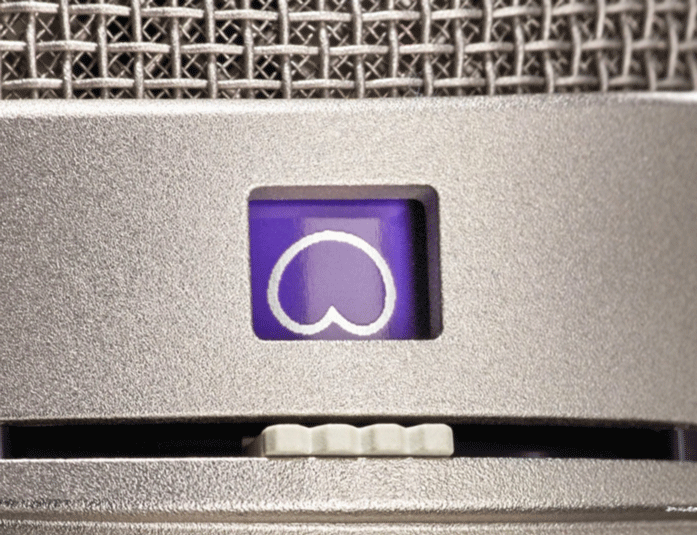
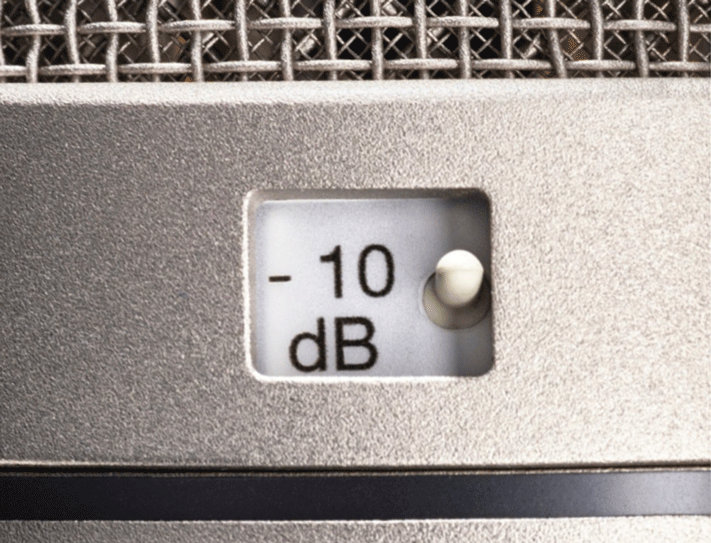
Double membrane capsule
Unlike many condenser microphones which have a single membrane design, the U87 utilises a dual membrane design. The membrane is a thin gold plated plastic material which vibrates as the sound waves hit, causing a small electrical signal. The double membrane capsule is made by essentially using two capsules in one, positioned back to back. This configuration is necessary to enable the figure of 8 polar pattern.
Neumann U87 Dimensions and Weight
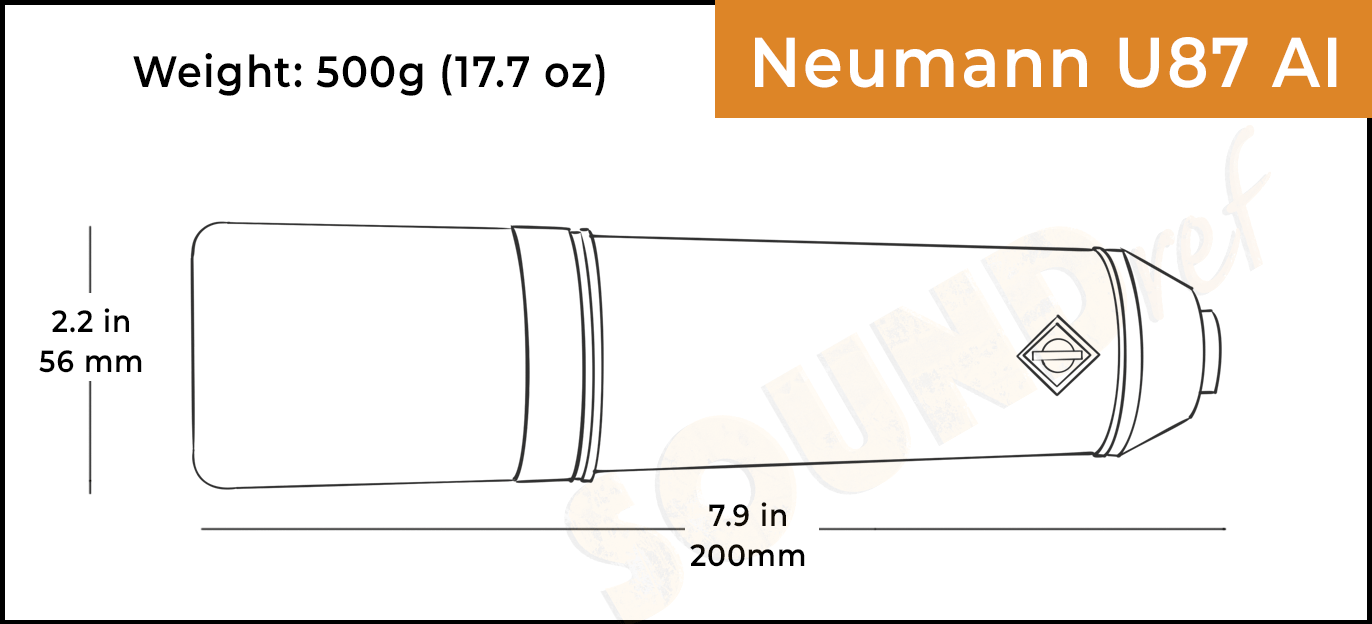
- Length 200 mm (7.9 inches)
- Width 56 mm (2.2 inches)
- Weight: 500g (17.7 oz)
While modern condenser mics have shrunk a little over the years, the U87 evolved from a tube microphone where more space was needed for components, and has kept its size and weight through various iterations.
The U87 is also heavier than some of the other large diaphragm condenser microphones, weighing in at 500g – a third heavier that the Rode NT1-A (326g). The weight won’t be an issue in the studio as long as you have some quality mic stands to keep them in place.
Neumann U87 frequency response
The Neumann U 87 AI has a wide frequency range of 20Hz – 20kHz. Looking at the charts, it’s striking how smooth and flat the frequency response is before a gentle lift in the high end.
The flat midrange results in a smooth and even sound, and the presence boost is just enough to bring out the clarity and detail of musical instruments and voices, without ever becoming too harsh.
With the low cut engaged, the response falls away very gently from 800Hz. I often find the low cut curve on other microphones to be too steep for practical use, but the gentle curve on the U87 stops the microphone from sounding unnatural or hollow at the bottom.
The on-axis frequency response is also impressively consistent across all three polar patterns with less variation than you’d normally expect from a multi pattern mic. That said, there are some small differences:
Omnidirectional frequency response
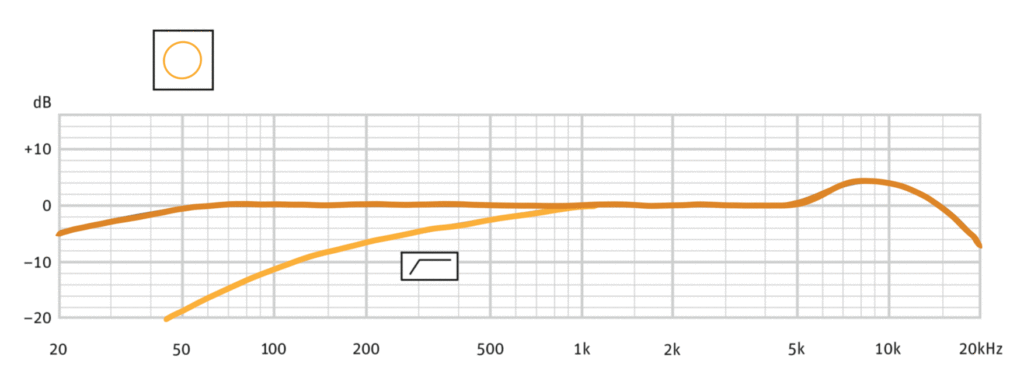
In omnidirectional mode, the U87 has a very flat response between 70Hz and 5kHz. Below 70Hz the bass rolls away very gently by 4db, and with the low-cut engaged it falls from 800Hz down to just below 50Hz. Above 5kHz there’s a pronounced presence boost between 5Hz up to 9kHz – perfect for those ‘larger than life’ vocals.
Cardioid frequency response
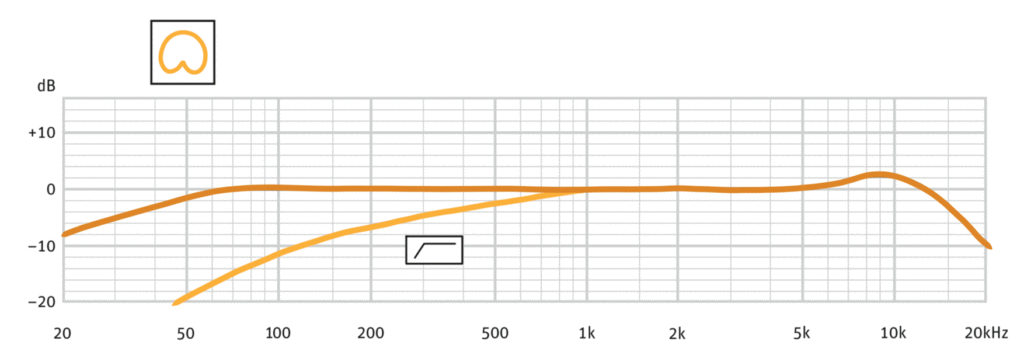
The Cardioid pattern is similar to omnidirectional in the midrange but with slight differences at the top and bottom. The low-end still begins to fall from 70Hz, but with a steeper curve leading to an 8dB drop at the bottom of the frequency chart.
With the low cut engaged, the response is the same as in omnidirectional mode. The presence boost at the top sits in the same place, but is far less pronounced – from 5kHz it climbs up 2db at 9kHz before gently rolling away.
Figure of eight frequency response
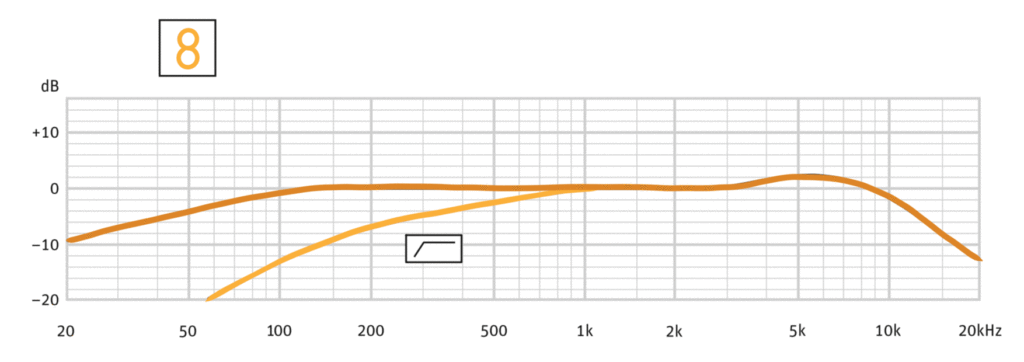
The frequency response for the figure of eight pattern is probably the most unique of the three. With the filter turned off there’s less bass, and the response falls away from about 120Hz. The low-cut is also a little steeper, bottoming out at around 60Hz. The presence boost sits a little lower in the frequency spectrum, climbing 2db from 3kHz up to around 5kHz before falling away.
Neumann U87 AI Sensitivity and Impedance
Like many large diaphragm studio condenser microphones, the U87 is very sensitive. This is one of the reasons it’s so clear and detailed, but watch out – the flip side to this as that it will pick every detail of background room noise.
The exact sensitivity specs vary a little depending on polar pattern, but it has a rating of 20 mv/PA and 22 mv/PA for omni and figure of eight patterns. The cardioid pattern is more sensitive with a rating of 28 mv/PA. The U87’s sensitivity is similar to other studio condensers such as the AKG 414.
The U87 has a low impedance rating of 200 ohms, which provides a clear, undistorted signal over longer cable-lengths. It has a max SPL of 117dB, but this can be increased to 127db by turning on the -10db pre-attenuation pad. With this SPL rating, the U87 wouldn’t be the natural choice for recording very loud instruments such as horns or drums. but 127dB will give you plenty of headroom for most situations in the studio.
The Neumann U87 AI has a self-noise rating of 12-15dBa (depending on polar pattern). This isn’t quite as quiet as some more modern mics, but it’s not significant – certainly quiet enough to not be noticeable in most recordings.
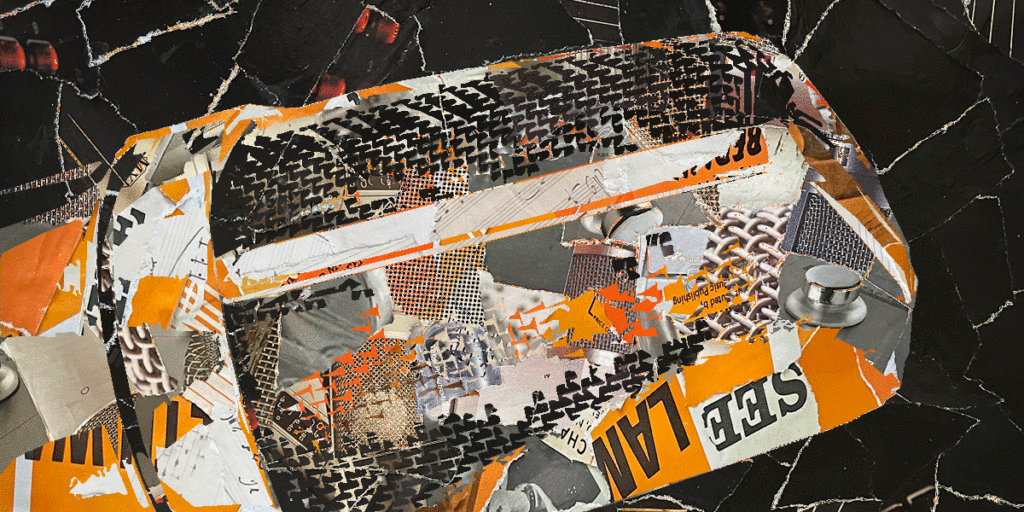
Neumann U87 AI Sound quality
The Neumann U87 is world renowned for its classy sound. Over the past 50 years, it’s earned a reputation as one of the best sounding studio microphones available. But does it really live up to these exemplary standards?
In many ways, when you use a really good microphone it doesn’t sound that remarkable, it just sounds right. This is how I’d describe the U87. It has a really smooth and even sound that seems to suit almost any instrument I put it in front of. The lows and mids are perfectly balanced – always present and controlled controlled, never muddy.
The high mids are flat, a contrast to some of the more ‘scooped’ modern condensers. And the high-end has a luxurious crispness and velvet detail, never coming close to harsh.
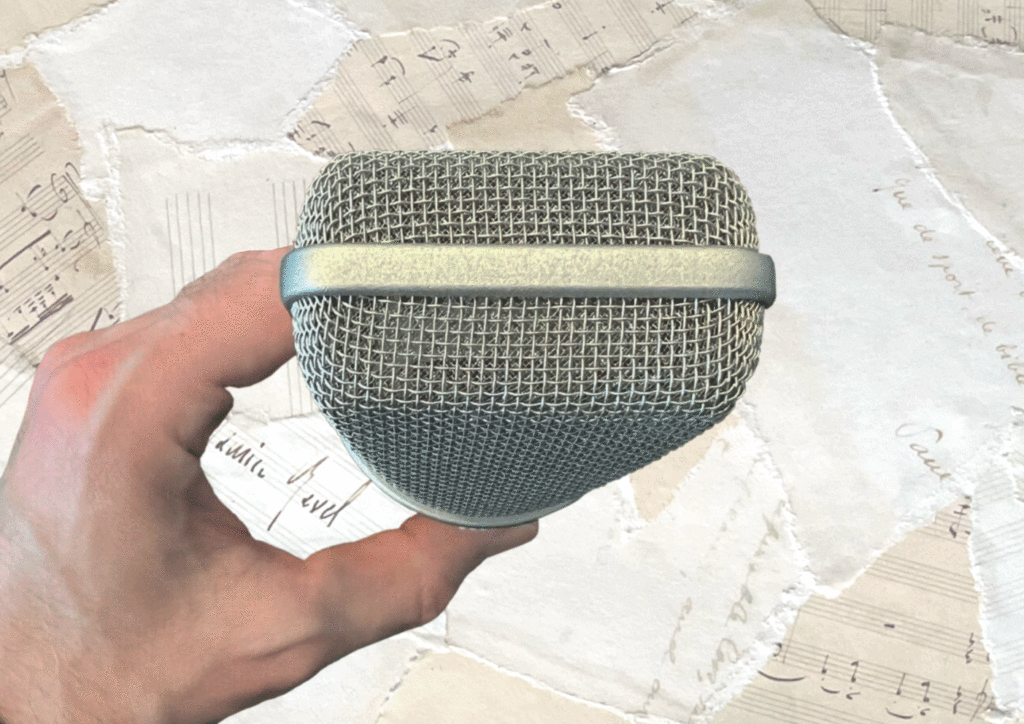
One thing I find quite special about the Neumann U87 is that all three polar patterns sound equally good. With a lot of multi-pattern mics, there’ are usually’s normally one or two patterns that sound great, with a degree of compromise on the others. With the U87, all three polar patterns have a very similar sounding frequency response and are equally usable.
The low-cut filter rolls away very smoothly and naturally, but it does cut out a significant amount of low-end which might be too much for some recording situations.
Neumann U87 for recording vocals
The U 87 is often used to record vocals due to its clear and balanced sound which seems to effortlessly sit in the mix. While it’s a classic choice for singers, especially male voices, (think Ed Sheeran, John Lennon, Marvin Gaye et al), it’s also great for the spoken word and voiceovers.
On both male and female vocals, the lows and mids have that magic combination of warm and full without ever becoming heavy. And the highs are have a warm clarity, never too sharp or sibilant. You can somehow get the full range and depth of a voice with it still sounding like a feather floating centre stage of the mix.
If you’ve got the room acoustics for it, try recording in omni mode for a natural full sound, standing a foot or two away from the mic. Though if you need more of the proximity effect (boosting the bass), try singing up close in the cardioid polar pattern mode.
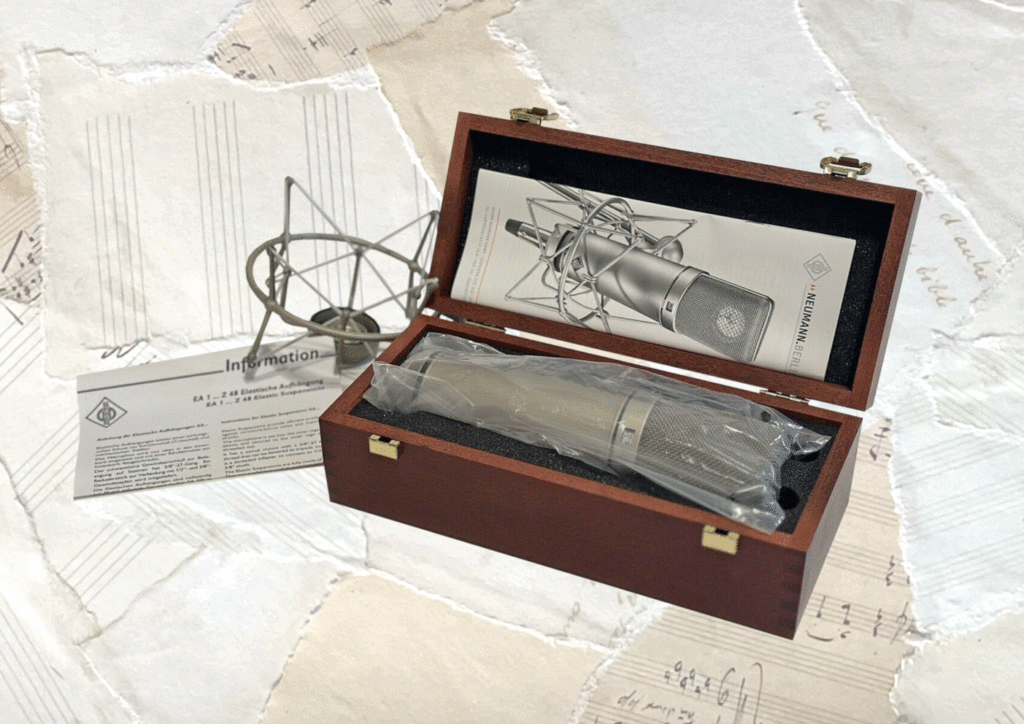
The figure-of-eight pickup pattern also gives you the option of picking up two singers at once, which can be a fun technique for recording backing vocals.
The Neumann U87 is quite prone to plosives, so you will need to use a pop-shield if you’re singing close to the mic. It also picks up any knocks and bumps from the mic stand quite easily, so using a shock-mount is also necessary for a pristine sound.
Neumann U87 for recording guitar
The U87 is often chosen for recording acoustic guitar, and I found it to be a great match for the small Taylor GS mini mahogany in the studio. It’s a small sized guitar, with a bright shimmery sound which can be prone to harshness with the wrong mic.
The U87 captured the high-end detail, giving some body to the sound in the mids and lows. When I paired this with a Shure SM57, I achieved some really lovely results, with a rich and vivid stereo image.
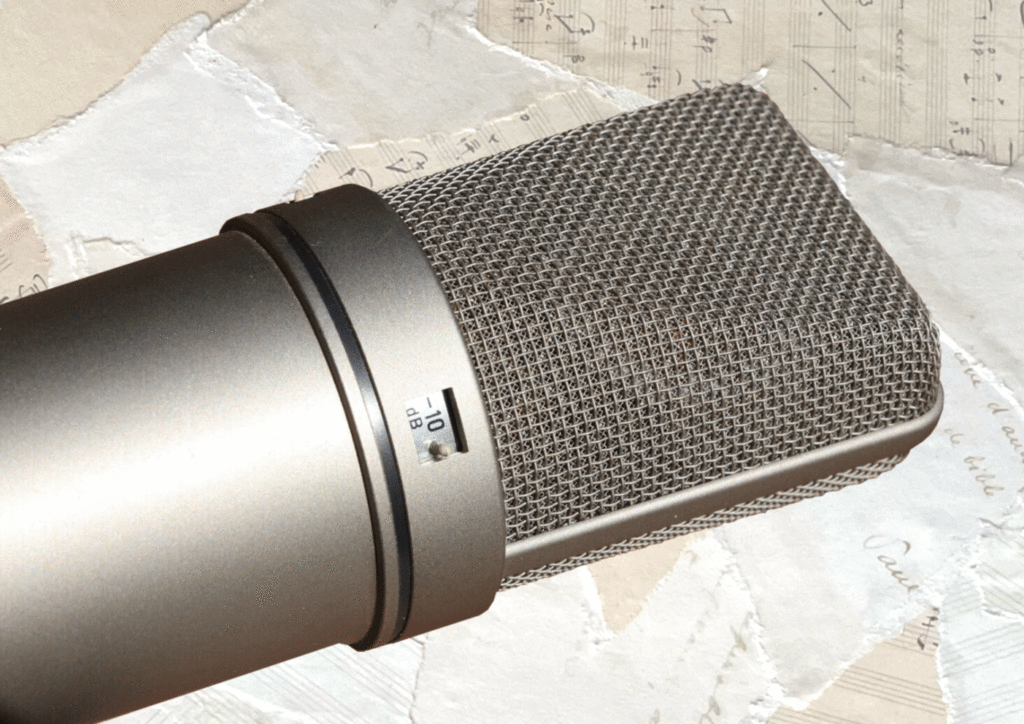
You can also use the U87 to mic up guitar-cabs and amplifiers and even bass amps. This will work for clean or slightly overdriven sounds, perhaps a Fender Twin Reverb, but probably not the best choice for heavily distorted guitar. You’re unlikely to overload the mic unless you really crank the volume, but its just not something I’d want to risk!
Neumann U87 AI in the recording studio
As well as voice and guitar, the U87 is a natural choice for a wide range of musical instruments and recording techniques. It’s always worth a try if you’re looking for a classy sound, rich with nuance, detail and depth.
I tried a single U87 on an upright piano, positioned about 2 feet away from the back. I thought it had quite a characterful sound, a warm even tone, still managing to pick up the subtle details of hammers and dampers from the front of the piano.
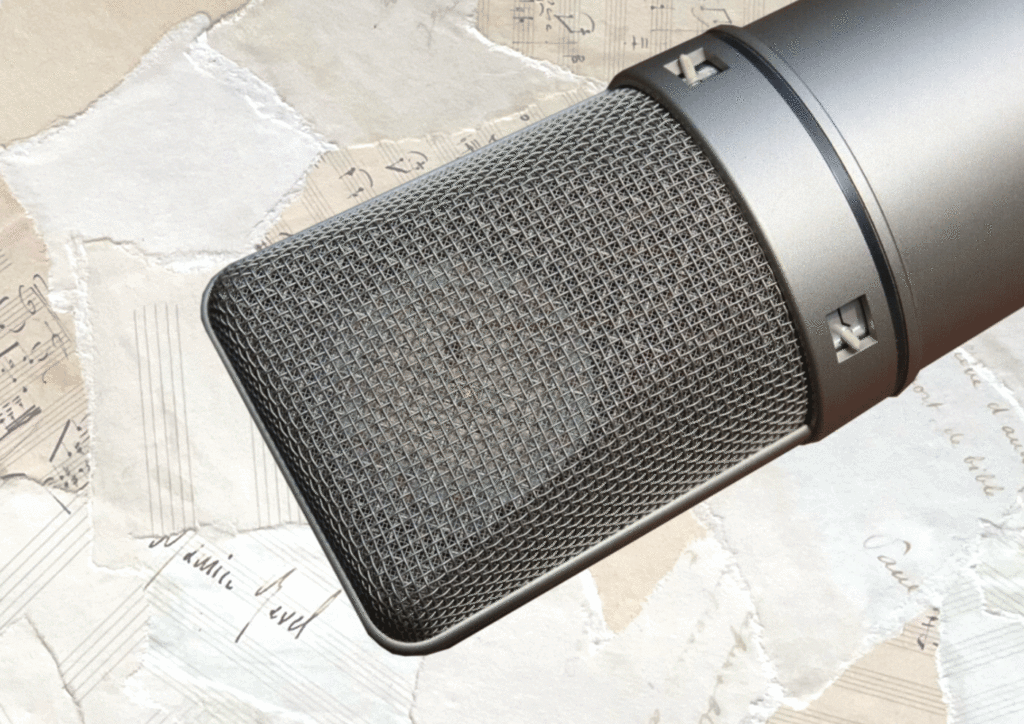
A note from site editor Daren Banarsë: “I used to use two U87s as a stereo pair to record my vintage Steinway grand for many adverts and film soundtracks when I ran a commercial studio in Hoxton.
In fact I used to call on that U87 pair for just about any stereo scenario – string quartets, a cello quartet. Of course it was also fantastic for voices of all types, and I remember recording a radio play with the two U87s in omni, and the whole cast gathered around them.”
The U87 is a true workhorse, performing well on woodwind instruments, choirs, and even as a set of warm overheads for a drum kit. It’s always worth trying in both omni and cardioid before you commit, if you have a decent enough sounding recording space, as the result can be quite different.
Despite its versatility, the one area where a U87 isn’t suitable is for recording very loud instruments. If you’re close-miking horns, drums or guitar cabs, I’d suggest trying different microphones – something less sensitive will be better suited to the louder sound sources.
How the Neumann U67 evolved into the U87
Before the U87, there was the U67. Released in 1960, the Neumann U67 was one of the first studio condensers made with the demands of rock and pop in mind. And it quickly became a favourite of several high profile artists such as The Beatles and Frank Sinatra.
The Neumann U67 is a studio condenser with a tube amplifier, and unlike the U87 it doesn’t run off phantom power – you’ll need a dedicated power supply. It has the same three switchable polar patterns as the U87 and the -10dB pad, and they share the same capsule design.
The most significant difference between the U87 and the U67 is that the U87 replaced the tube amp circuitry with brand new (for 1967) solid state technology. Since their release, both microphones have undergone a few revamps, and you can currently buy a reissue of the original U67 if you have deep pockets.
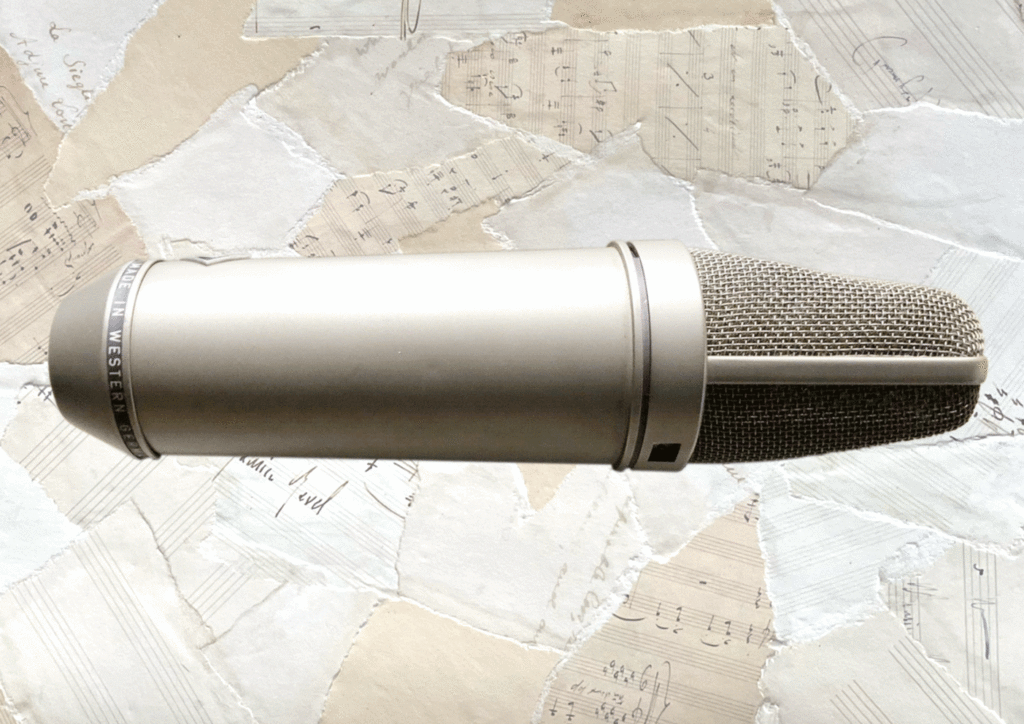
Perhaps unsurprisingly, both the U67 and U87 have very similar sounds, but with some subtle differences. The U67 has more of a vintage tone, with more prominent mids, and less of an emphasis on the high-end. It also adds a lovely silky smooth texture, sounding very rounded on vocals. In comparison, the U87 sounds a little brighter, and more modern.
Just like the U87, the U67 is also a legendary microphone with few other mics available for comparison. The real downside, is that the current reissued version will set you back a little under $7,000. This is way over twice the price of one U87 and the equivalent budget to some readers whole studio!
Neumann U87 AI vs Rode NT1-A
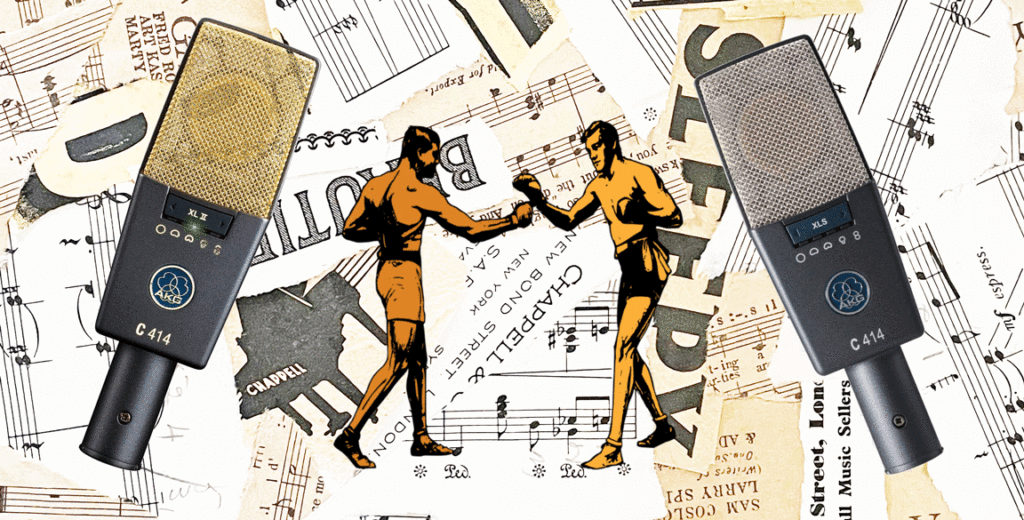
One of the most popular studio mics for the more budget end of the consumer market is the Rode NT1-A. Rode are an Australian company making affordable yet high-quality microphones since the mid 90s. The NT1-A is a fixed-pattern cardioid condenser, and a sibling of the popular NT1 microphone. Compared to the NT1, it has a slightly different frequency response and is particularly well suited to vocals. At the time of writing, the Rode NT1-A retails for around 10% of the price of a U87!
So why compare the U87 with cheaper microphones? It might seem like the NT1-A and the U87 are in a completely different class, but I have some surprising news. In a direct comparison, the Rode NT1-A really holds its own, especially considering its low price. It has a clear and neutral sound with just enough brightness to add sparkle to acoustic guitar and vocals. By contrast the U87 sounds smoother and warmer, qualities that give it its distinctive classic tone.
Given the price difference, the NT1-A is an excellent choice for anyone on a budget, but still needs high quality recordings. But for the keen-eared perfectionists, there really is no substitute for the sound of the Neumann U 87 AI, and well worth the hefty price tag.
Read the full Rode NT1-A review here
Neumann U87 AI vs AKG C414 XLII
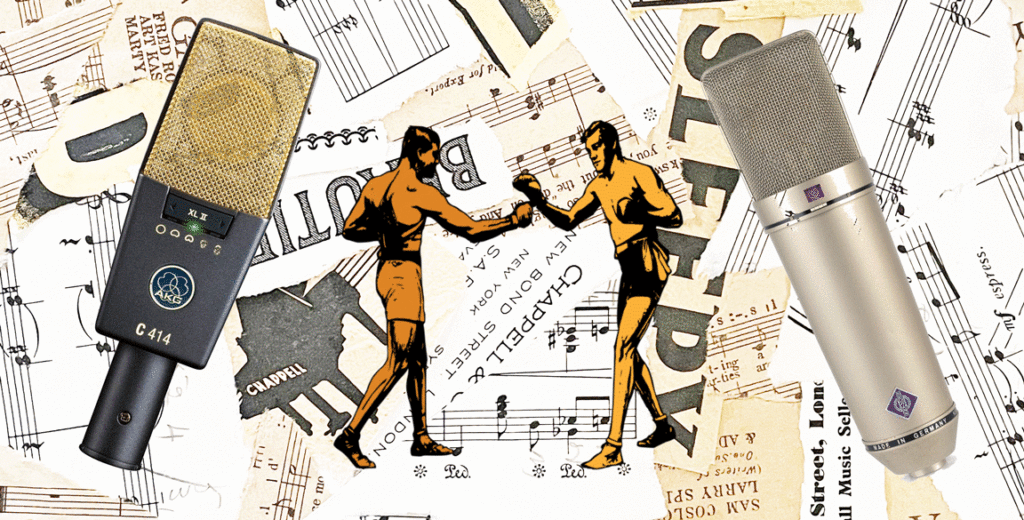
Another classic microphone with a long history is the AKG C414. Like the U87, it originally evolved from a tube microphone, the C12. The original C414 was then released in 1971, not long after the U87. Since then, the C414 has undergone a number of revamps before arriving at two models – the C414 XLII for vocals and the the C414 XLS for instruments. Here we-re comparing the AKG C414 XLII.
A thoroughly modern mic, the AKG C414 XLII has a host of features that ramp up its versatility and usefulness in the studio. It has 9 switchable polar patterns including cardioid, wide-cardioid, hypercardioid, omnidirectional, and figure-of-eight.
It has a choice of 3 bass-cut filters at 40, 80 and 160Hz, rather than the one bass roll of on the U87. And it also has 3 pre attenuation pads at -6, -12, and -18dB, rather than the one -10dB pad on the U87. The C414 also has a max SPL of 140db, which is 13db higher than the U87, making it more useful for louder instruments.
Add all of this up, and you get a remarkably versatile studio mic which you can customise to just about any recording scenario. The high SPL makes it a good choice for horns or drum overheads, but it also performs superbly on acoustic guitars, vocals and other instruments.
Compared to the U87, the AKG C414 has a notably cleaner, more modern sound. It’s a brighter mic, good for bringing out more sparkly top-end detail, and doesn’t have as much body as the U87 in the mids and lows. It offers a lot of crisp fidelity, but lacks the characteristic warm smoothness of the Neumann mic.
The C414 XLII is a fantastic mic, and is a great addition to any good studio. It’s about half the price of the U87, so clearly better suited to many budgets. But if you’re looking for the very best, I;m afraid you’ll have to reach deep and go for the Neumann U87
What else do you need?
The Neumann U 87 AI comes in a custom wooden storage box as standard. You’ll also need a shock mount, stand, cable and pop shield.
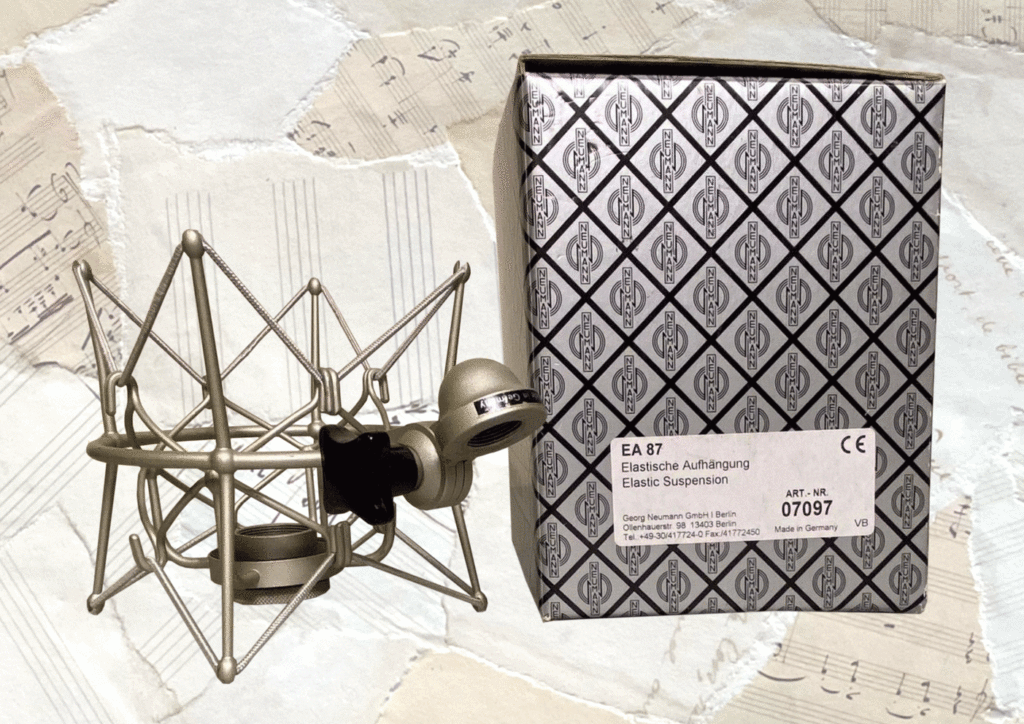
- Shock mount
If you’re spending this much on a legendary mic, I think it makes sense to splash out on one of Neumann’s dedicated U87 shock mounts. Even if you’re at the end of your budget, you will need a third party shock mount for the best and cleanest sound. Try one like the Rycote Universal, which you’ll be able to use for your other mics as well.
- Microphone stand
Large diaphragm condenser mics like these have to be mounted on a stand. This will reduce any handling noise in the studio. Try a good quality boom stand, with a tripod base like the K&M 210/2
- XLR cable
If you invest in a premium condenser microphone such as the C414, it’s definitely worth getting a good quality cable. If you want the best quality XLR cables, try these. Go for the shorter lengths where possible.
- Pop filter
You don’t need to spend much on a pop filter. Try one like this, or have a go at making one yourself out of an old pair of tights!
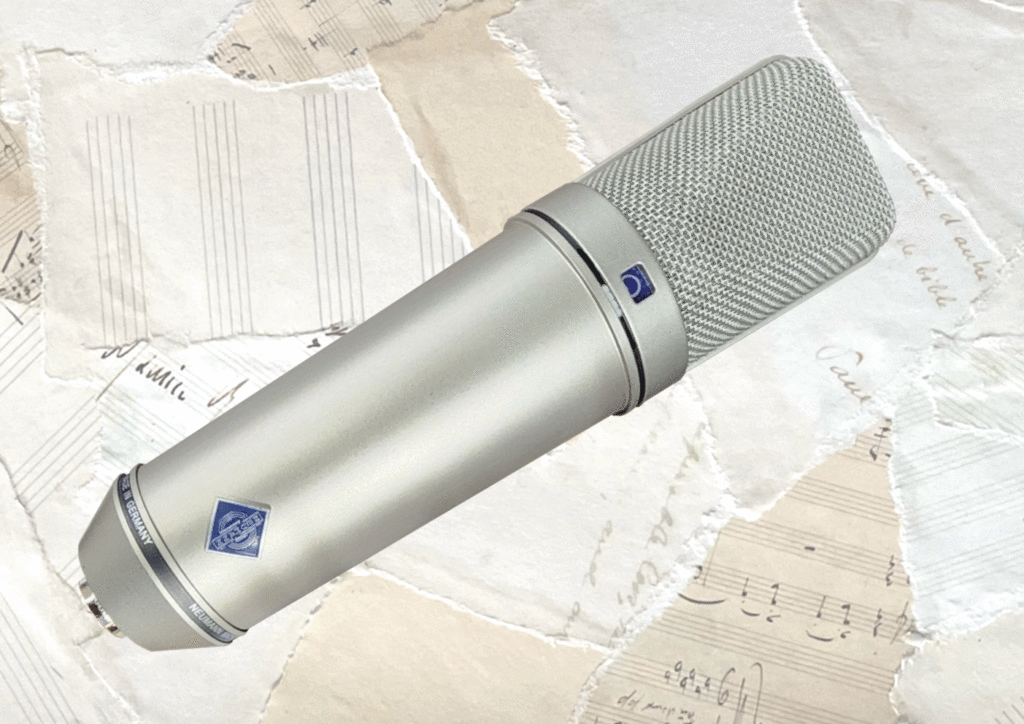
Conclusion
Over the last 50 years, the Neumann U87 has earned its place in recording history, and it’s not hard to see why. It has an impeccable hand-crafted build, clear, even sound with tons of detail, and the added versatility of 3 different polar patterns.
The obvious downside to this microphone is the eye watering price. For many of you, it will simply be outside of your budget. If this is the case, don’t fret. There are many mics, including high quality studio condensers available which cost much less.
However if you’re one of those people who need the very best, or the competitive edge, you’re simply going to have to save up for a U87. You won’t be disappointed.
Neumann U87 AI Frequently Asked Questions
Does the Neumann U87 need phantom power?
The Neumann U87 is a condenser microphone, so it does require phantom power. You can receive power from the mixing desk, audio interface or a stand-alone unit
Can you use condenser mics on stage?
Condenser mics are a great choice for stage use as long as they have been designed specifically for live use. They’ll deliver a higher quality sound than dynamic mics.
Which artists use the Neumann U87
The Neumann U87 has been used throughout history by some of the biggest names in the industry, including Kurt Cobain, Paul McCartney, Ed Sheeran and David Bowie.
Read about our pick of the best mics for recording vocals
